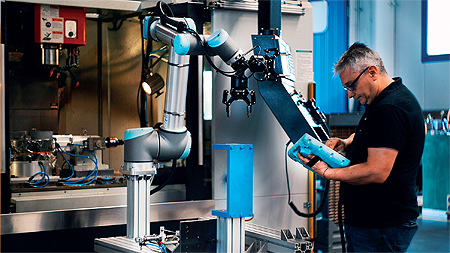The potential of automation
It’s been well publicised that modern manufacturing has been shaped by the current landscape of de-industrialisation and the resulting change in composition of output. The European manufacturing sector is resultantly going through a difficult period, which has seen its worst year since 2012 across the continent. Even Germany, the industrial bedrock of the Eurozone had its least productive year since 2009 – with orders dropping nearly nine per cent. These problems have been further exacerbated by factory shutdowns in China, leading to a shortage of components, particularly in automotive manufacturing.
Another widespread problem facing the sector is the skills shortage and ageing workforce, with major manufacturers going to great lengths to lessen the effects of these issues. For instance, Porsche are using every possible measure to retain their ageing workforce for as long as they can by making their factories as ergonomic as possible. To reduce work-place injuries they’re altering productions lines and using inventive strategies to protect staff, like suspending and rotating cars at head height so employees can remain seated and not have to look up whilst they work.
While these sorts of unique counter-strategies are effective, not every manufacturer has the resources to alter their production lines so drastically automation- whilst managing to retain a profitable output. Therefore, manufacturers need to look to the least invasive solutions to improve productivity and efficiency that doesn’t require a complete restructure of operations.
Robots or Cobots?
Traditional industrial robots have much more stringent health and safety regulations, meaning human co-workers have to be separated by fencing and must keep their distance. Which  works very well when producing the same product line continuously, as it requires very little human supervision or interaction. These industrial robots are ideal for high-volume mass production settings, but lack the flexibility needed today, which means that even making a minimal change to how or where they operate is costly, time-consuming and requires skilled personnel to programme them.
works very well when producing the same product line continuously, as it requires very little human supervision or interaction. These industrial robots are ideal for high-volume mass production settings, but lack the flexibility needed today, which means that even making a minimal change to how or where they operate is costly, time-consuming and requires skilled personnel to programme them.
Therefore, flexible and affordable technology, such as collaborative robots or ‘cobots’, should be a priority investment for manufacturing businesses as this type of technology can be adapted to different tasks as simply and effortlessly as possible. This is ideal for the majority of SMEs, who usually produce much more specialised products which can require day-to-day changes in the production line – often, with little notice. Therefore, the ability to be flexible and highly responsive to the industry landscape and customer demands is the number one priority.
‘Mythbusting’
There are many perceived roadblocks to adopting automation. But manufacturers need to disregard the common misconception that automation is out of reach to SMEs as it’s exorbitantly expensive and only reserved for large corporations. What is important is that SME manufacturers are exposed to and aware of the huge range of machinery available, or risk being left behind.
Similarly, there’s a widespread fear from employees that automating factory processes will leave them jobless. Though often linked to AI, the truth is automation rarely means having machines thinking for themselves and taking over the jobs of the human workforce. It is actually quite the opposite, as the most successful automation projects use robots purely as tools, which only enhances the existing labour force and makes them more efficient. While it’s true that some tasks such as basic pick and place may become obsolete for employees, overall, they will be more satisfied as they’ll be able to be upskilled into more rewarding positions such as quality 7assurance, management and back office. This also has the added benefit for businesses to attract and retain new recruits more easily.
Outlook for the future
Despite the prevalence of misconceptions about automation and new ways of working, the truth is that the end result will be an increased yield and faster production times with more customisation. A report by the Boston Consulting group (BCG) even asserts that the United Kingdom could use technology to increase industrial efficiency by up to 25 per cent, seeing manufacturing sector growth of up to three per cent per year. This figure illustrates the power of these technologies and is indicative of the potential opportunity for other countries, if they’re able to settle on the right technologies. Of course, introducing cobots and automation isn’t a cure-all for the industry and can’t solve the sectors inherent issues, but it should give manufacturers, of all sizes, a respite from the employee shortages and the demographic ‘time bomb’ facing the sector.
Though we’re seeing worrying signs of decline, and the sector regularly achieving milestones of poor performance, this likely won’t last. Embracing new technology should be the long-term solution to enable organisations to increase production efficiency and drive value to ensure future success in the sector. The advent of new technologies like data analytics, robots and cobots, multi-purpose production lines and intelligent machines is quickly making the smart factory a reality. Which will allow manufacturers to produce much more, with less personnel, and dramatically alter the current landscape for the better.
Mark Gray
Mark Gray is UK Sales Manager at Universal Robots. Universal Robots was founded in 2005 to make robot technology accessible to all by developing small, user-friendly, reasonably priced, flexible industrial robots that are safe to work with. Since then, the company’s cobots have become the most widely-deployed collaborative robot (cobot) manufacturer in the world.
www.universal-robots.com
